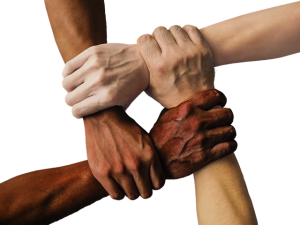
2. Celebrating others.Children’s books are wonderful resources for helping your child develop a sense of his or her own identity, as well as an understanding of those who are different in terms of race, family composition, religious beliefs and ability. Visit your library for books such as: It’s Okay to be Different (diversity); The Skin You Live In(acceptance); Same, Same But Different (culture and geography); Whoever You Are(diversity); Where Does God Live (religion); What is God (religion); Over the Moon (adoption); Don’t Call Me Special (disabilities); My Brother Sammy(autism); and The Family Book (different family configurations).
3. Exposure to other cultures brings personal meaning.While children’s books open children’s eyes to differences, actual experiences have the most profound influence on what children think and believe. Here are more hands-on activities you can try:
- Encourage cross-racial/ethnic/religious/ability friendships.
- Expose your children to foods from different cultures, like classic pork and cabbage dumplings or kimchi.
- Attend different events/festivals that celebrate a particular ethnic group, holiday or personal accomplishment, like the Special Olympics, the Chinese New Year or Holi, the Hindu festival of colors.
- Whether big or small, children’s or history museums house an abundance of artifacts from different cultures and countries. Since museums can be overwhelming for young children it helps to talk with your child about what you will see, what she wants to learn and then focus on that part of the museum (especially if the museum is large).
- Watch movies set in other cultures like My Neighbor Totoro, Kirikou and the Sorceress, and The Red Balloon.
4. The most powerful role model.While all of the activities listed above have been found to promote cultural awareness and respect, no activity is as powerful as the role model of a child’s parent(s). Children become culturally sensitive and respectful when they see adults who are culturally sensitive and respectful, and who take a stand against bias, racism or insensitivity.
Lastly, it is important for adults to take a “strengths based” perspective when talking with children about those who are different from the child. This perspective focuses on the positive characteristics of a person and her abilities, what that person is able to do or does (as compared to what he cannot) and how differences make our world a better place.
By helping your child understand and respect similarities and differences, you will help him realize he is a wonderfully unique person among many other wonderfully unique people on this earth.
Proceeds from the sale of books purchased at Amazon.com help support PBS Parents. Thank you!
Author:
Christy Tirrell-Corbin, PhD is the Director of Early Childhood/Early Childhood Special Education at the University of Maryland where she teaches a course entitled, Culture and Community Perspectives: The Diverse World of the Child. Dr. Tirrell-Corbin’s research interests focus on family engagement, notably around teachers’ beliefs and practices around issues of race and culture. She also serves as a consultant for several educational organizations, including PBS Kids and National Geographic. Follow her on Twitter @TirrellCorbin.
0 Comments